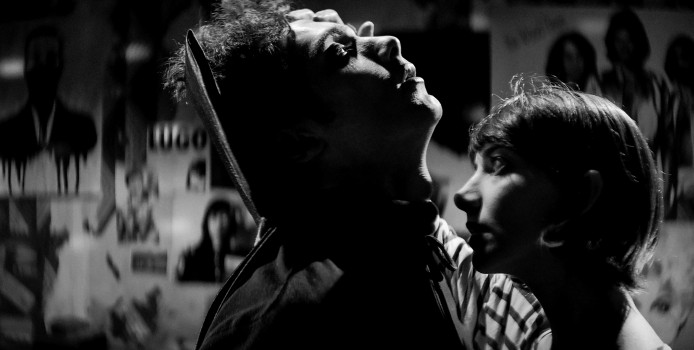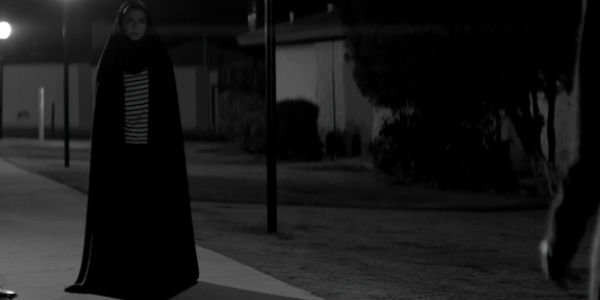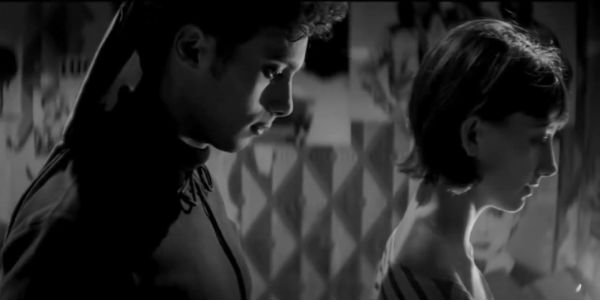A GIRL WALKS HOME ALONE AT NIGHT: An Emotive Mix Of Genres

Cherokee is a 20-something human from London, UK. She has…
About 20 minutes into A Girl Walks Home Alone at Night, the local drug dealer, Saeed (Dominic Rains), takes a girl (Shelia Vand) back to his flat. His place is pretty pimped out. Think a toned-down version of Alien’s crib in Spring Breakers – the mounted animal heads, the fur carpets and nice furniture, the suitcase filled with drug money and coke lined up on the glass table next to it.
Saeed does about three lines, pumps some weights, and dances like Napoleon Dynamite. It’s funny. Like, Willem Dafoe Wild at Heart funny. It’s not even a couple of minutes later when Saeed’s finger is bitten off and the unnamed girl is crouched on top of him, sucking the remainders of blood out of his neck. Turns out she is a vampire and he picked up the wrong girl.
After Saeed is well and truly gone, and The Girl pockets his expensive-looking watch, she then hears someone shouting outside the flat. It’s Arash, (Arash Marandi), a James Dean-like character with slicked back hair, a black leather jacket and jeans. He has beef with Saeed. Hossein (Marshall Manesh), Arash’s dad, hasn’t been able to pay off his debts for his ‘medicine,’ so Saeed took the keys to Arash’s one and only possession, his car, as payment. Arash is at Saeed’s flat to get it back.
When The Girl comes out of the building, a patch of blood still on her face, she and Arash briefly make eye contact, and then go their separate ways. This is the scene that sold me on the film.
A mixture of genres
A Girl Walks Home Alone at Night isn’t defined by one genre or tone. It can be a horror film when it wants to, and also an oddball comedy just as easily. It can cut to symbolic imagery at the same time that it looks like a music video. There are discussions on mortality paired with conversations about Lionel Richie. That’s why it is so good. (I’ll forever be questioning how Ana Lily Amirpour, the film’s director, got everything to work as well as it does.)

It’s a snippet of the lives of four characters who live in a fictional Iranian town, Bad City: Arash, Hossein, The Girl, and the sex worker she protects at night, Atti (Mozhan Marnò). Their stories are neatly intertwined, too – Arash and Hossein are father and son, Arash and The Girl are two lost souls looking for some kind of solace, Hossein is one of Atti’s clients, and The Girl watches over Atti. Even the young kid (Milad Eghbali) who follows Arash around has a connection to the story, and quite a pivotal one at that.
We’re all human, anyway
What really brings the film together, though, is the constant feeling of humanity in those that live in Bad City. Every character wants to belong, and they are all searching for something, although they don’t know what yet (or are too scared to admit it). They’re not really good people, but they’re not bad either. It’s a moral questioner.
Vand brings a loving sensitivity paired with a punkish attitude to the character of The Girl. She jams to records in her room and skates around at night, exuding an effortlessly cool vibe. Then, she switches. She plays the part of what we would expect from a vampire – menacing at every turn, the thought of which would give you tossing and turning nightmares. One second she is someone you want to chill with, the next she is very likely to eat your heart. Literally.

As Arash, Marandi is kind of similar. Perhaps that is why he and The Girl found a strong bond between them. He can be charming and cheeky and everything else you thought he would be. But he can also turn into a much darker character and make decisions that he doesn’t want to, yet stands by as right at the time. He isn’t a vampire, though, he’s human.
The film puts its human and supernatural characters on the same pedestal, without judgement. This, and the sense of reality even through all of the surrealism and dream sequences, are one of its strengths. The performances build around the ghost-town world, but the visuals truly enhance it and capture the emotional depth.
The substance vs. style debate
The shots of The Girl standing in gloomy alleyways, or Arash coming up on a pill, or the hormonal awkwardness between Arash and The Girl, which is not just endearing but uncomfortably real – all these scenes are elevated by the lack of colour and the shadows that populate the movie. I couldn’t imagine A Girl Walks Home Alone at Night working as well as it did if it wasn’t filmed in black and white.
It’s easy enough to make the criticism that it’s all a surface level story; that there isn’t anything underneath it but having nice cinematography (which Lyle Vincent should get all the praise for). But there is substance within the style, and a lot of it. It carries an unexpected emotive weight in the darkness of each frame. Some decisions in films are made for purely stylistic reasons, but that isn’t the case here.
Conclusion
Amirpour has made something that should be embraced – a different and obscurely unique film. It’s odd just as much it is funny, tension-filled just as much as heartbreaking. Honestly, though, who doesn’t want to see a film with a young, Hijabi vampire rocking out to records in her bedroom?
Do you think that the different genres in A Girl Walks Home Alone at Night work well together, or is it trying to be too many things at once? Drop us a comment below and let us know what you think.
(top image source: Kino Lorber)
Does content like this matter to you?
Become a Member and support film journalism. Unlock access to all of Film Inquiry`s great articles. Join a community of like-minded readers who are passionate about cinema - get access to our private members Network, give back to independent filmmakers, and more.
Cherokee is a 20-something human from London, UK. She has a morbid fascination with Justin Bieber, is a collector of cute hats and watcher of bad Asian rom-coms and B-movies. She can usually be found in her fortress of solitude - lying in bed with a comic book in hand. You can check out more of her writing at www.cherokeeseebalack.tumblr.com. Jim Jarmusch is her hair inspiration, Tahar Rahim is her forever-film crush and one day she hopes to be as cool as Marlon Brando.













